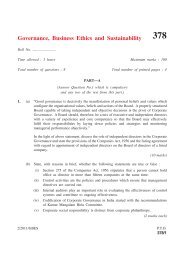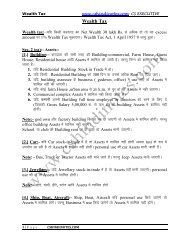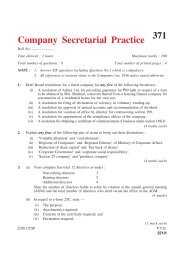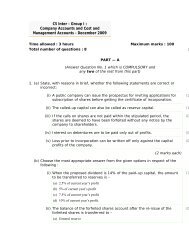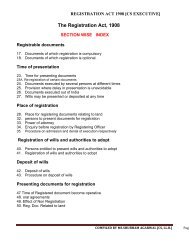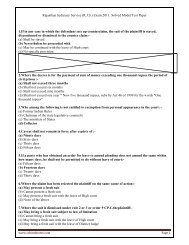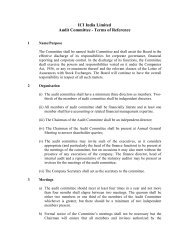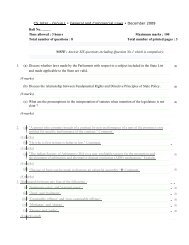CS EXECUTIVE SOLVED PAPER GCL GENERAL AND ... - cs notes
CS EXECUTIVE SOLVED PAPER GCL GENERAL AND ... - cs notes
CS EXECUTIVE SOLVED PAPER GCL GENERAL AND ... - cs notes
Create successful ePaper yourself
Turn your PDF publications into a flip-book with our unique Google optimized e-Paper software.
<strong>CS</strong> <strong>EXECUTIVE</strong> <strong>SOLVED</strong> <strong>PAPER</strong><br />
<strong>GCL</strong><br />
<strong>GENERAL</strong> <strong>AND</strong> COMMERCIAL LAWS<br />
<strong>SOLVED</strong> <strong>PAPER</strong><br />
<strong>CS</strong> Executive Programme Module-I (New Syllabus)<br />
December - 2010<br />
Chapter - 1 : Constitution of India<br />
2010 - Dec [1] {C} (a) Article 32 of the Constitution of India empowers the Supreme Court to<br />
enforce the fundamental rights guaranteed under Part III of the Constitution of India. Explain<br />
with the help of decided case law how the provisions of Article 32 of the Constitution of India,<br />
have helped in the enforcement of fundamental rights.(8 marks)<br />
(b) Discuss the ordinance making powers of the President of India and of the Governor of a<br />
State as provided in the Constitution of India.(6 marks)<br />
Answer :<br />
(a) When the Supreme Court issues writs under Article 32 of the Constitution, they are mainly<br />
for the enforcement of fundamental rights mentioned in the Constitution itself. Remedies<br />
against violation of fundamental rights are available in the Constitution and under the<br />
ordinary laws both, but Article 32 makes it a fundamental right that a person whose<br />
fundamental right is violated has the right to move the Supreme Court by appropriate<br />
proceedings for the enforcement of his fundamental right. However, this right is purely<br />
remedial and not substantive. Moreover, a person need not first exhaust the other remedies<br />
and then go to the Supreme Court; he can directly raise the matter before the highest Court<br />
of the land and the Supreme Court is empowered to issue directions or orders or writs for<br />
the enforcement of the right which has been alleged<br />
The right available under this article can only be taken away or recalled when the Constitution itself<br />
is amended; there is no other way to abridge or remove it. It applies not only to the territory within<br />
the national bounds of the country but also to the area outside India which India controls, such as its<br />
consulates and embassies. Under this article, not onlY can any law be questioned, but it also<br />
extends to executive orders.The Madras High Court held in Aditanar Educational Institution v.<br />
Assistant Director of Income-tax (297 I.T.R. 376) has held that the relief under Article 32 is<br />
preferred in case there is no other recourse available.<br />
(RAMDAS ATHAWALE ........... PETITIONER VERSUS UNION OF INDIA<br />
RESPONDENTS)<br />
(b) According to Article 53 of the Constitution of India, the President is the chief of the Executive<br />
and in this capacity he enjoys the power to make ordinances under Article 123 of the Constitution.<br />
This power comes into play when it is not possible to make enactments through the normal<br />
constitutional machinery. Some important points related to this power are as follows –<br />
-This power can be exercised for making any ordinance that is immediately needed.<br />
Keep visiting www.<strong>cs</strong>hindi<strong>notes</strong>.com Page 1
<strong>CS</strong> <strong>EXECUTIVE</strong> <strong>SOLVED</strong> <strong>PAPER</strong><br />
<strong>GCL</strong><br />
-The President can make ordinances on any item on which the Parliament can legislate,but is<br />
currently unable to do so.<br />
-Such ordinances will be temporary in effect, and they have to be placed before the Parliament<br />
when it is next in session.<br />
Ordinance making power of the Governor of a state as provided in the Constitution of India<br />
Under Article 213 the Governor has the power to make ordinances for a state when the<br />
house or houses of the state re not in session and it is essential to make a law. This is a part<br />
of the legislative powers given to the governor under the Constitution of India.<br />
The following important points in this regard have to be kept in mind –<br />
-This power can be utilized in cases of exigency.<br />
-If there is a normal route to make the law available it must be followed.<br />
-It can only be used to make laws that can be passed without the sanction of the President. -The<br />
ordinance would only have temporary powers, and will have to be laid down before the houses<br />
when they are next in session.<br />
This power will be used when both the houses or one house is not in session and it is not possible to<br />
make a law with the one house in session.<br />
Chapter - 2 : Interpretation of Statutes<br />
2010 - Dec [1] {C} (c)<br />
“Rule of ejusdem generis is merely a rule of construction to aid the courts<br />
to find out the true intention of the legislature.” Explain.(6 marks)<br />
Answer :<br />
Rule of Ejusdem Generis - It is one of the basic principles of interpretation. The term itself<br />
means ‘of the same kind’, and helps when the statute is not clear as to the implications and<br />
coverage. The rule says that when there is a specific class or classes of acts or things or persons<br />
defined in an Act, any word occurring subsequently will be bound by their coverage, i.e. a wider<br />
meaning than the one defined cannot be taken. For example, under the Central Excise Tariff Act,<br />
there are lists of items that come under the same head. If one of the lists say that it is to include<br />
textile articles, viz, clothing, sheets, bed covers, etc., it can in no way be inclusive of articles that<br />
cannot be termed strictly as being made of textile, like sheets made majorly of a synthetic fibre,<br />
though containing a small percentage of cotton fibre. Hence, if the list is an exhaustive or fairly<br />
indicative list, a wider meaning cannot be given to it.<br />
If, however, there is no specific list, or the class is not that well defined, the application<br />
could cover a wider scope. The universal logic behind this principle is that if a statute had been<br />
intended for a general coverage, it would not have included specific words to define the scope<br />
of its usage. It is essential though, that this rule should be used with discretion, because there<br />
exists the practical risk of the act becoming too specific for actual use.<br />
Keep visiting www.<strong>cs</strong>hindi<strong>notes</strong>.com Page 2
<strong>CS</strong> <strong>EXECUTIVE</strong> <strong>SOLVED</strong> <strong>PAPER</strong><br />
<strong>GCL</strong><br />
This rule is merely a rule of construction to help the Courts to find out the true intention of<br />
the Legislature (Jage Ram v. State of Haryana, AIR 1971 SC1033). In order to make the rule<br />
applicable, the following conditions must exist:<br />
(1) The statute contains an enumeration by specific words,<br />
(2) The members of the enumeration constitute a class,<br />
(3) The class is not exhausted by the enumeration,<br />
(4) A general term follows the enumeration,<br />
(5) There is a distinct genus which comprises more than one species, and<br />
(6) There is no clearly manifested intent that the general term be given a broader meaning that<br />
the doctrine requires.<br />
Hence, we can safely conclude that "Rule of ejusdem generis is merely a rule of construction to<br />
aid the courts to find out the true intention of the legislature."<br />
Chapter - 3 : An Overview of Law Relating to Specific Relief; Arbitration and Conciliation<br />
Torts; Limitation and Evidence<br />
2010 - Dec [2] Write <strong>notes</strong> on the following :<br />
(i) Circumstantial evidence(4 marks)<br />
(ii) Appointment of experts by an arbitral tribunal under the Arbitration and Conciliation<br />
Act, 1996.(4 marks)<br />
(iii) The rule of strict liability as laid down in Rylands vs. Fletcher(4 marks)<br />
(iv) Rules relating to presumption(4 marks)<br />
Answer :<br />
(i) Circumstantial evidence is that derived from the surrounding facts. For example, if in a<br />
room, an attempt to murder has taken place, the state of the things in the room will be<br />
taken into consideration as circumstantial evidence. For although, the state of things by<br />
itself is not sufficient proof that a murder took place, but it can strongly indicate to it,<br />
through the signs of struggle in the room, the sight of blood, a weapon lying on the<br />
ground etc. In the absence of primary evidence, circumatantial or secondary evidence can<br />
be relied upon to give an idea about the situation. It cannot, however, be used by itself<br />
in murder cases.<br />
Under Section 60 of the Evidence Act of the English law, the expression "direct<br />
evidence" is not intended to exclude circumstantial evidence of things which could be<br />
seen, heard or felt. Thus, evidence whether direct or circumstantial under English law is<br />
"direct" evidence under Section 60. Before acting on circumstances put forward are<br />
satisfactorily proved and whether the proved circumstances are sufficient to bring the<br />
guilt to the accused the Court should not view in isolation the circumstantial evidence<br />
but it must take an overall view of the matter.<br />
Keep visiting www.<strong>cs</strong>hindi<strong>notes</strong>.com Page 3
<strong>CS</strong> <strong>EXECUTIVE</strong> <strong>SOLVED</strong> <strong>PAPER</strong><br />
<strong>GCL</strong><br />
(ii) Section 26 of the Arbitration and Conciliation Act, 1996 says that the tribunal can take the<br />
help of an expert for opinions on any matter in the proceedings. The expert can contribute by being<br />
a part of the proceedings and forwarding his reports, if any, to the tribunal. His reports also have to<br />
be forwarded to both the parties to arbitration. Theexperts can be appointed subject to agreement<br />
between the parties. Clause (b) ofSub-section (1) of the Section obligates the parties to provide the<br />
expert access tonecessary information and documents. Conversely, there is a duty placed on the<br />
expertunder Section 26(3) to make available to the parties on their request the various documents<br />
etc. on which the expert has based his report. This will enable the parties to present counter<br />
questions or objections.<br />
Strict liability or absolute liability – This liability arises when some harm takes place<br />
without any intention or negligence on the part of the defendant, even then he is liable<br />
for it. This can happen in any of the following cases –<br />
-Unavoidable accidents –When a person is doing some work, which, if it goes wrong, is liable to<br />
cause harm to another, it will bring liability upon him even if the harmful substances were being<br />
kept and maintained by another on his land. For instance, if someone has a godown, which he leases<br />
to another, and if that otheR causes some illegal activity to take place in that place, the owner is also<br />
liable fo it-Unavoidable mistake – When a person affects another’s tangible or intangible property,<br />
for example, someone who gives wrong information about another to the press has to undertake full<br />
liability for it.<br />
The rule of strict liability in Rylands v. Flethcer(1868) L.R. 3 H.L. 330 is that a man acts<br />
at his peril and is the insurer of the safety of his neighbour against accidental harm. Such<br />
duty is absolute because it is independent of negligence on the part of the defendant or<br />
his servants.<br />
In this case, B, a mill owner employed independent contractors, who were apparently<br />
competent to construct a reservoir on his land to provide water for his mill. There were<br />
old disused mining shafts under the site of the reservoir which the contractors failed to<br />
observe because they were filled with earth. The contractors therefore, did not block<br />
them. When the reservoir was filled, the water from it burst through the old shafts and<br />
flooded the plaintiff's coal mines on the adjoining land. It was found as a fact that B did<br />
not know of the shafts and had not been negligent, though the independent contractors<br />
were definitely negligent, and B was held liable.<br />
The Indian Evidence Act of 1872 recognizes some rules as to presumptions.<br />
Presumptions are used in the interpretation of statutes only when the intention of the legislature is<br />
not clear; when it is clear, they are to be avoided. Conjecture or suppositions are used when it<br />
becomes difficult to comprehend the statute in its own light. The basic presumptions used in the<br />
interpretation of statutes are as follows –<br />
(i) The words used in the statute have been used in the literal sense with precise meanings unless<br />
Keep visiting www.<strong>cs</strong>hindi<strong>notes</strong>.com Page 4
<strong>CS</strong> <strong>EXECUTIVE</strong> <strong>SOLVED</strong> <strong>PAPER</strong><br />
<strong>GCL</strong><br />
otherwise defined.<br />
(ii) There has been effected no change I the rights of the people unless the statute prescribe such a<br />
change expressly.<br />
(iii) Liability only attaches where there is mens rea (guilty mind).<br />
(iv) The state or governmental institutions, unless expressly covered, are deemed to be exempte<br />
(v) The legislature, while passing the new statute was aware of the manner of functioning of the<br />
judiciary and the executive as well as the legal condition in the<br />
country and unless stated, has not caused any changes in it.<br />
(vi) No mistakes have been committed by the legislature in drafting the statute.<br />
(vii) No pointless activity would be enjoined on the people.<br />
(viii) The statute has been made with a view to exercise the powers given through it<br />
equitably and fairly.<br />
(ix) Where the statute creates a legal duty that is accompanied by a legal power, an cannot stand<br />
without it, it is assume both go together.<br />
2010 - Dec [4] (a) Explain with illustration the doctrine of ‘damnum sine injuria’ and ‘injuria<br />
sine damnum’.(6 marks)<br />
Answer :<br />
(a) Injuria sine damnum – ‘Injuria’ means ‘infringement’ of some legal right. ‘Damnum’<br />
means ‘actual damage or loss’, caused either to the person or to the property of the<br />
aggrieved. Injuria sine damnum gives the aggrieved the right to proceed in a court of law,<br />
as his legal rights have been harmed. For example, trespass gives the owner the right to sue<br />
the trespasser.<br />
Damnum sine injuria – This implies that although there have been loss caused to the<br />
aggrieved, he cannot sue as there has been no infringement of any legal rights. For example,<br />
if a trespasser entered a property and was injured by the owner’s dog, there is no legal<br />
remedy if the owner has a board outside saying, “Do not trespass. Beware of dog.”<br />
2010 - Dec [7] (b) Anil prefers an appeal for setting aside the arbitral award on the ground that<br />
he was not given a proper notice of arbitral proceedings and thereby not being able to present<br />
his case. He also furnishes sufficient proof and pleads before the court the he received the arbitral<br />
award just 15 days back. Decide with reasons —<br />
(i) whether Anil with succeed in his prayer; and<br />
(ii) whether the law of limitation will not be a bar (5 marks)<br />
Answer :<br />
An arbitral award can be set-aside on application to the High Court having jurisdiction, and any<br />
civil court of an inferior grade. This has been provided under Section 34 of the Arbitration and<br />
Conciliation Act, 1996.<br />
The grounds based on which an application under this section can be filed are as follow –<br />
• Invalid or unacceptable arbitration agreement<br />
• Incapacity of parties<br />
• Improper notice of arbitration proceedings<br />
• Inability in presenting a proper case to the arbitral authority<br />
Keep visiting www.<strong>cs</strong>hindi<strong>notes</strong>.com Page 5
<strong>CS</strong> <strong>EXECUTIVE</strong> <strong>SOLVED</strong> <strong>PAPER</strong><br />
<strong>GCL</strong><br />
• Award not according to the terms of reference<br />
• Improperly constituted arbitral tribunal<br />
• Proceedings not as per agreement<br />
• Award against the public policy of India<br />
• Matter of dispute not capable of being the subject matter of arbitration<br />
The application for setting aside an award has to be made within three months of receiving the<br />
award. If there is a previous application for correction or interpretation of the award already<br />
pending, the time would be counted from the date of disposal of that application. This period can<br />
be extended on proof of sufficient cause for not presenting the application being evident.<br />
Hence, the court may set aside the arbitral award or may provide relief in accordance with<br />
Section 34(2) of the Act, and Anil will succeed in his prayer.<br />
The law of limitation will not create any bar, since the period of limitation has not expired in<br />
view of the provisions of Section 34(3).<br />
2010 - Dec [8] (b) Amrit contracts “Bhushan to sell a piece of land consisting of five bighas of<br />
land for Rs. 5 lakh. Subsequently, it turns out that only four bighas of land belongs to Amrit.<br />
Whether specific enforcement of such part-contract may be possible on the part of either party<br />
to the contract Decide by referring the specific provisions of the Specific Relief Act, 1963. (5<br />
marks)<br />
Answer :According to Section 12 of this Act, specific performance of a part of a contract shall not<br />
normally be ordered. The section, however, contains some exceptions as laid down in<br />
sub-sections 2 to 4. These are as follows–<br />
-When the part of the contract that is left unperformed is comparatively a smaller portion as<br />
compared to the part that is performed, then part performance is ordered. For the leftover<br />
part, compensation is deemed to be adequate relief.<br />
-When the party has done some portion of the work desired, and the leftover portion cannot<br />
be done, then the other party will pay an amount as reduced by the consideration for the<br />
non- performed part. Another alternative could be that the party pays the entire sum and<br />
relinquishes all rights to the balance work left.<br />
-When the contract is such which has two portions: one that can be specifically performed<br />
and another that cannot, the court can order one portion to be specifically performed. For<br />
example, if A promised to sell two houses, X and Y to B, but before the date of the<br />
transaction being completed, house Y got destroyed, the court can orer A to hand over<br />
house X to B.<br />
In the given problem Amrit contracts Bhushan to sell a piece of land consisting of 5 bigha of land<br />
for Rs 5 lakh. It turns out that only 4 bighas of land belong to Amrit The one bigha is not necessary<br />
for the use or enjoyment of the 4 bighas, nor of such nature that the loss cannot be compensated in<br />
money. Amrit may be ordered to convey to Bhushan the 4 bighas and to compensate him for the<br />
loss of one bigha or conversely,Bhushan, at the suit of Amrit, may be ordered to pay to Amrit, the<br />
Keep visiting www.<strong>cs</strong>hindi<strong>notes</strong>.com Page 6
<strong>CS</strong> <strong>EXECUTIVE</strong> <strong>SOLVED</strong> <strong>PAPER</strong><br />
<strong>GCL</strong><br />
stipulated purchase money, less the sum awarded as compensation for the deficienc, on receiving<br />
the conveyance and possession of the land.<br />
Chapter - 4 : Law Relating to Transfer of Property<br />
2010 - Dec [2] Write <strong>notes</strong> on the following :<br />
(v) Spes successionis.(4 marks)<br />
Answer :<br />
Properties that cannot be transferred have been defined in Section 6 of the Transfer of Property<br />
Act, 1882. According to this, the rights of an heir apparent or someone who has a chance to<br />
obtain the rights at a later date, but who has still not obtained them, are known as the chances<br />
of an heir apparent or ‘spes successionis’.<br />
For example, A, in the hope that since he is the only child of his parents, will be the heir of the<br />
entire estate, has entered into a contract with B, for the sale of a house that he hopes to get. This<br />
transfer is not valid till the will takes effect upon the father’s death, and A actually obtains the<br />
property.<br />
Where a person wants to make a gift of the property which is to come in his hands in future, he<br />
cannot transfer it because a gift is voluntary transfer without any consideration. Thus a gift of<br />
future property is void. Similarly, the chance of a heir apparent succeeding to the estate of a<br />
deceased person cannot be transferred.<br />
2010 - Dec [3] Distinguish between the following :<br />
(i) ‘Condition restraining alienation’ and ‘condition restraining enjoyment’.<br />
(ii) ‘Mortgage’ and ‘charge’.<br />
(iii) ‘Sale’ and ‘contract for sale’.(4 marks each)<br />
Answer :<br />
(i) According to Section 10 of the Transfer of Property Act, 1882 the right of absolute<br />
alienation of property is not to be allowed to the transferor. Partial restraint, however, is<br />
allowed under the Act.<br />
Partial restraint implies transfer of property to another with a condition that does not<br />
make transfer impossible per se but limits it under certain conditions. For example, a<br />
condition attached to a family settlement that a transferor has to offer his share to a<br />
family member first and then to a stranger, is valid.<br />
Absolute restraint is not allowed as it limits the transferee from freely transferring the<br />
property as he thinks fit. The term might also apply to restrictions placed on the<br />
enjoyment of acquired property. For example, a condition that the transferee cannot<br />
further sell the land except when the price is above a fixed sum comes under this term.<br />
However there are certain exceptions to Section 10.<br />
1. A condition that the lessee cannot further sublet the property is valid.<br />
2. In the case of a woman to whom the Hindu, Buddhist or Muslim personal law does<br />
not apply shall not have power to transfer the property as long as her marriage<br />
subsists.<br />
Restraint on enjoyment :<br />
Keep visiting www.<strong>cs</strong>hindi<strong>notes</strong>.com Page 7
<strong>CS</strong> <strong>EXECUTIVE</strong> <strong>SOLVED</strong> <strong>PAPER</strong><br />
<strong>GCL</strong><br />
Section 11 of the Act also embodies a rule which is based on the principle that restraint on the<br />
enjoyment of the property is invalid. The section lays down that where land is transferred by one to<br />
another, the transferor should not impose conditions as to how and in what manner the transferee<br />
should enjoy the property. As for instance, A sells his house to B and adds a condition that B only<br />
should reside in that house, the condition is invalid. This is subject to the exception that, if a person<br />
transfers a plot of land keeping another plot for himself, he can impose certain conditions which<br />
may interfere with the right of enjoyment of the transferee.<br />
(ii)Please Refer 2008 - Dec [4] (vi) on page no. 123<br />
Sale – As per Section 54 of the Transfer of Property Act, a sale is a transfer of property<br />
to another for consideration that is paid or promised, or partly paid and partly promised.<br />
The essentials of a sale are as under –<br />
(a) The seller must be a person competent to transfer. The buyer must be any person<br />
who is not disqualified to be the transferee under Section 6(h)(3).<br />
(b) The subject matter should be capable of being defined as transferable property.<br />
(c) There is a transfer of ownership.<br />
(d) It must be an exchange for a price paid or promised or part paid and part promised.<br />
(e) There must be present a money consideration. Any other valuable consideration but<br />
money makes it an exchange or barter but not a sale.<br />
Contract for sale<br />
A contract for the sale of immoveable property will be specifically enforced by a court<br />
unless special reasons to the contrary are shown. For example, if in a contract, A agreed<br />
to sell to B a plot X, this is a contract of sale, and specific performance of the contract<br />
can be ordered by the court.<br />
2010 - Dec [5] (c) Abhay’s agricultural land was purchased by the government for the purpose<br />
of construction of a factory but no duty was paid for this transfer by the government. Abhay<br />
wanted to take back his land on the ground that the government has not paid the duty and,<br />
therefore, no sale deed was executed. Will Abhay succeed Give reasons.(4 marks)<br />
Answer :Section 3 of the Indian Stamp Act, 1899 dealing with instruments chargeable with duty<br />
provides<br />
certain exceptions stating that no duty shall be chargeable in respect of any instrument executed<br />
by or on behalf of or in favour of the Government, in cases where, but for this the Government<br />
would be liable to pay the duty chargeable in respect of such instrument.<br />
In this case, Abhay's agricultural land was purchased by the government for the purpose of<br />
construction of a factory but no duty was paid for this transfer by the government. Abhay wanted<br />
to take back his land on the ground that the government has not paid the duty and, therefore, no<br />
sale deed was executed. As per the provisions of the section it appears that the government is not<br />
liable to pay duty. Therefore the instrument falls under the exception and it is not void. Abhay<br />
cannot take back his land on this ground.<br />
2010 - Dec [8] (a) Ajoy voluntarily makes a gift of his immovable property to Bijoy. Bijoy<br />
Keep visiting www.<strong>cs</strong>hindi<strong>notes</strong>.com Page 8
<strong>CS</strong> <strong>EXECUTIVE</strong> <strong>SOLVED</strong> <strong>PAPER</strong><br />
<strong>GCL</strong><br />
accepts the gift. The possession of the property was given to Bijoy but the gift deed which<br />
required registration under section 123 of the Transfer of Property Act, 1882 was not registered.<br />
Whether Ajoy, the donor can revoke the gift Decide.(6 marks)<br />
Answer :This is covered under Section 123 of The Registration Act, 1908. According to this<br />
section, a<br />
gift of immovable property needs to be made by a registered document that is signed by the<br />
donor or by his authorized representative. Moreover, it needs to be attested by at least two<br />
witnesses. In addition, it needs to be accepted by the donee during the lifetime of the donor in<br />
order to have a binding effect. Non-acceptance will vitiate the gift.<br />
Such a deed can be registered anytime within the period specified under the Act, and even a<br />
subsequent registration will have the same effect as if it was registered upon execution. As in the<br />
case of Kalyana Sundaram Pillai vs. Karuppa Mopanar, non-registration of the deed will not<br />
render the gift invalid, and if it is presented within the reasonable time, it can be duly registered.<br />
Ajoy can not revoke the gift, as in this case, other than registration, the gift is complete and valid<br />
according to the provisions of Section 122 of the Transfer of Property Act, 1882.<br />
Chapter - 5 : Law Relating to Stamps<br />
2010 - Dec [4] (b) List any ten instruments which are chargeable with duty under the Indian<br />
Stamp Act, 1899.(5 marks)<br />
Answer : Instruments chargeable with duty as specified under Section 3 of the Indian Stamp Act,<br />
1899 and<br />
as indicated in Schedule I annexed to the Act, are as under -<br />
1. Mortgage deeds<br />
2. Share warrants<br />
3. Trust deeds<br />
4. Instruments of partnership<br />
5. Certificate of sale<br />
6. A memorandum of agreement<br />
7. Power of attorney<br />
8. Lease agreements<br />
9. Partition award<br />
10. Protest of bill or note<br />
Chapter - 7 : Law Relating to Information Technology<br />
2010 - Dec [3] Distinguish between the following :<br />
(v) Electronic form’ and ‘electronic record’.(4 marks)<br />
Answer :<br />
As per the Information Technology Act, 2000 electronic form with reference to information,<br />
means "any information generated, sent, received or stored in media, magnetic, optical, computer<br />
memory, microfilm, computer generated micro fiche or similar device". [Section 2(1 )(r)].<br />
Keep visiting www.<strong>cs</strong>hindi<strong>notes</strong>.com Page 9
<strong>CS</strong> <strong>EXECUTIVE</strong> <strong>SOLVED</strong> <strong>PAPER</strong><br />
<strong>GCL</strong><br />
Electronic record means "data, recorded or data generated, image or sound stored, received or<br />
sent in an electronic form or microfilm or computer generated micro fiche". [Section 2(1 )(t)]<br />
2010 - Dec [4] (c) What are ‘cyber offences’ under the Information Technology Act, 2000 (5<br />
marks)<br />
Answer :<br />
Please Refer 2010 - June [2] (iii) on page no. 176<br />
Chapter - 8 : The Code of Civil Procedure, 1908 (C.P.C)<br />
2010 - Dec [3] Distinguish between the following :<br />
(iv) ‘Set-off’ and ‘counter-claim’.<br />
Answer :Please Refer 2008 - Dec [4] (ii) on page no. 187<br />
(4 marks)<br />
2010 - Dec [7] (c) Ram and Shyam sell rice for Rs. 25,000 to Sohan and Mohan. Sohan sells<br />
cloth worth Rs. 28,000 to Shyam. Sohan files a suit against Shyam for recovery of price of cloth.<br />
Shyam claims set-off of the cost of rice in this suit. Will he succeed (5 marks)<br />
Answer : ‘Set off’ means a settlement where both the plaintiff and the defendant have some claims<br />
to be collected from each other. What one party owes to another might be used to discharge all or a<br />
part of the debt he is owed by the other party.<br />
In the given case, Sohan is the plaintiff while Shyam is the defendant. The amount of which<br />
set-off is claimed by the defendant Shyam is not recoverable from Mohan, who is jointly liable<br />
with Sohan to pay it. Mohan is not party to this suit.<br />
In view of the factual situation, Shyam will not be allowed set-off of the amount claimed by him,<br />
as set off is allowed only against those parties which are jointly liable in the first place.<br />
Chapter - 9 : The Code of Criminal Procedure, 1973<br />
2010 - Dec [7] (a) A magistrate of the first class passed a sentence of imprisonment for a term<br />
of three years with a fine of Rs. 4,000 and in lieu of non-payment thereof an additional<br />
imprisonment for another one year. Has the aggrieved person any right to appeal against this<br />
sentence (6 marks)<br />
Answer :<br />
Section 29 of the Code of Criminal Procedure, 1973 specifies the sentencing powers of<br />
Magistrates. So far as the Magistrate of the first class is concerned, as per Section 29 of the<br />
Code, a Magistrate of the first class may pass a sentence of imprisonment for a term not<br />
exceeding three years or of a fine not exceeding five thousand rupees or of both.<br />
Section 30 of the Code specifies the limits of Magistrate's powers. It provides that the Court of<br />
a Magistrate may award such term of imprisonment in default of payment of fine as is authorised<br />
by law provided the that the term:<br />
(i) is not in excess of the powers of the Magistrate under Section 29; and<br />
Keep visiting www.<strong>cs</strong>hindi<strong>notes</strong>.com Page 10
<strong>CS</strong> <strong>EXECUTIVE</strong> <strong>SOLVED</strong> <strong>PAPER</strong><br />
<strong>GCL</strong><br />
(ii) where imprisonment has been awarded as pat of the substantive sentence, it<br />
should not exceed 1 /4th of the term of imprisonment which the Magistrate is competent to inflict<br />
as punishment.for the offence otherwise than as imprisonment in default of payment of the fine.<br />
The Aggrieved person has a right to appeal against the sentence of the First Class Magistrate,<br />
as the sentence awarded by him for default of payment of fine exceeds the limit stipulated under<br />
Section 30 of the Code (1/4th of three years, i.e. the period for which the magistrate may<br />
pronounce punishment, is less than one year).<br />
2010 - Dec [8] (c) Angad is charged for murder of Binod. The charge sheet is filed in the court<br />
of Chief Judicial Magistrate, who passed an order of sentence of imprisonment for life. Angad<br />
engages you as an advocate. Advise the course of action to Angad giving reasons. (5 marks)<br />
Answer :<br />
According to Section 29 (1)of the Code of Criminal Procedure, the court of a Chief Judicial<br />
Magistrate may pass any sentence authorised by law except a sentence of death or of<br />
imprisonment for life or of imprisonment for a term exceeding seven years.<br />
In this case, the Chief Judicial Magistrate passed an order of sentence of imprisonment for life.<br />
He has exceeded the limit of his powers provided under Section 29 of the Code. Angad would<br />
be aadvised to file an appeal in the High Court against the order of the Chief Judicial Magistrate.<br />
Chapter - 11 : Objective Questions<br />
2010 - Dec [5] (a) Re-write the following sentences after filling-in the blank spaces with<br />
appropriate word(s)/figure(s):<br />
(i)………………….is issued to an inferior court preventing the latter from usurping (i) A writ of<br />
jurisdiction which is not legally vested in it.<br />
(ii) A decree through which the right as to any property or the legal character of a person is<br />
judicially ascertained is known as……………….<br />
(iii) The word ‘tort’ is a French equivalent of English word…………<br />
.<br />
(iv) All documents produced for inspection of the court are called<br />
Of<br />
(v) The provisions regarding use of adhesive stamps are given under section the Indian Stamp Act,<br />
1899.<br />
(vi) The statement given by the court on the grounds of a decree or order as defined in section 2(9)<br />
of the Code of Civil Procedure, 1908 is known as………….<br />
(b) Choose the most appropriate answer from the given options in respect of the following :<br />
(i) The relief of cancellation of a written instrument is available under the Specific Relief<br />
Act, 1963 —<br />
(a) When an instrument is void or voidable at the option of plaintiff<br />
Keep visiting www.<strong>cs</strong>hindi<strong>notes</strong>.com Page 11
<strong>CS</strong> <strong>EXECUTIVE</strong> <strong>SOLVED</strong> <strong>PAPER</strong><br />
<strong>GCL</strong><br />
(b) When the plaintiff may apprehend serious injury if the instrument is left outstanding<br />
(c) Where the instrument requires registration but is not registered<br />
(d) Where the conditions (a) and (b) mentioned above are fulfilled.<br />
(ii) An award may be challenged on the ground of —<br />
(a) Incapacity of a party<br />
(b) Invalidity of an arbitration agreement<br />
(c) Both (a) and (b)<br />
(d) None of the above.<br />
(iii) The Parliament is empowered to make laws on the subjects enumerated in —<br />
(a) List-I<br />
(b) List-II<br />
(c) Both List-I and List-II<br />
(d) None of the above.<br />
(iv) As per the Registration Act, 1908 a testator may deposit with any Registrar his will in<br />
a sealed cover with the name of the testator —<br />
(a) Personally<br />
(b) Through an agent<br />
(c) Through any person<br />
(d) Either (a) or (b).<br />
(v) Where possession of the property is to be given to the mortgagee, the mortgage is<br />
called —<br />
(a) Usufructuary mortgage<br />
(b) Simple mortgage<br />
(c) Anomalous mortgage<br />
(d) None of the above.<br />
(vi) Summary trials will apply to those offences which are not punishable with imprisonment<br />
for a term exceeding —<br />
(a) Two years<br />
(b) One year<br />
(c) 60 Days<br />
(d) 90 Days.(1 mark each)<br />
Answer :<br />
(a)(i) A writ of prohibition is issued to an inferior court preventing the latter from usurping<br />
jurisdiction which is not legally vested in it.<br />
(ii) A decree through which the right as to any property or the legal character of a person is<br />
judicially ascertained is known as declaratory decree.<br />
(iii) The word 'tort' is a French equivalent of English word wrong .<br />
(iv) All documents produced for inspection of the court are called documentary evidence.<br />
(v) The provisions regarding use of adhesive stamps are given under Section 11 of the Indian<br />
Stamp Act, 1899.<br />
(vi) The statement given by the court on the grounds of a decree or order as defined in Sec.<br />
2(9) of the Code of Civil Procedure, 1908 is known as judgement.<br />
(b)(1) (d) Where the conditions (a) and (b) mentioned above are fulfilled.<br />
Keep visiting www.<strong>cs</strong>hindi<strong>notes</strong>.com Page 12
<strong>CS</strong> <strong>EXECUTIVE</strong> <strong>SOLVED</strong> <strong>PAPER</strong><br />
<strong>GCL</strong><br />
(ii) (c) Both (a) and(b)<br />
(iii) (c) Both List-I andList-II<br />
(iv) (d) either (a)or (b)<br />
(v) (a) Usufructuary mortgage<br />
(vi) (a) Two years.<br />
2010 - Dec [6] State, with reasons in brief, whether the following statements are true or false :<br />
(i) Certain categories of information have been exempted from disclosure under the Right to<br />
Information Act, 2005.<br />
(ii) Article 174 of the Constitution of India empowers the Governor of a State to dissolve the<br />
State Legislature. (iii) Arbitration is the means by which the parties to a dispute get it settled<br />
through the intervention of a third person.<br />
(iv) The limitation for taking cognizance of certain offences has been prescribed by the Code<br />
of Criminal Procedure, 1973.<br />
(v) If the parties to arbitration fail to determine the number of arbitrators, the arbitral tribunal<br />
shall consist of three arbitrators.<br />
(vi) An easement can be transferred apart from dominant heritage.<br />
(vii) The doctrine of part-performance is applicable only where the transferee has taken<br />
possession of the immovable property.<br />
(viii) A judicial proceeding under the Code of Criminal Procedure, 1973 includes inquiry, trial<br />
and investigation.(2 marks each)<br />
Answer :<br />
State, with reasons in brief, whether the following statements are true or false:<br />
(i) Correct: Under Section 8 of the Right to Information Act, 2005 certain categories of<br />
information have been exempted from disclosure.<br />
(ii) Correct: Article 174(2) of the Constitution expressly vests in the Governor the power<br />
of dissolving State Legislature.<br />
(iii) Correct: Arbitration is the means by which parties to a dispute get the same settled<br />
through the intervention of a third person (or more persons) but without recourse to a<br />
court of law.<br />
(iv) Correct; Chapter XXXVI of the CR.P.C prescribes limitation period for taking<br />
cognizance of certain offences.<br />
(v) Incorrect: As per Section 10 of the Arbitration and Conciliation Act, 1996 if the parties<br />
failed to determine the number of arbitrators, the arbitral tribunal shall consist of a sole<br />
arbitrator.<br />
(vi) Incorrect : An easement cannot be transferred as apart from the dominant heritage. It<br />
is a right ancillary to the enjoyment of the land and cannot be separated from it.<br />
(vii) Incorrect: All the ingredients of Section 53A of the Transfer of Property Act, 1882<br />
should be present.<br />
(viii) Incorrect : The term judicial proceeding includes inquiry and trial but does not include<br />
investigation. [Section 2(i)] of the Cr.P.C]<br />
Keep visiting www.<strong>cs</strong>hindi<strong>notes</strong>.com Page 13


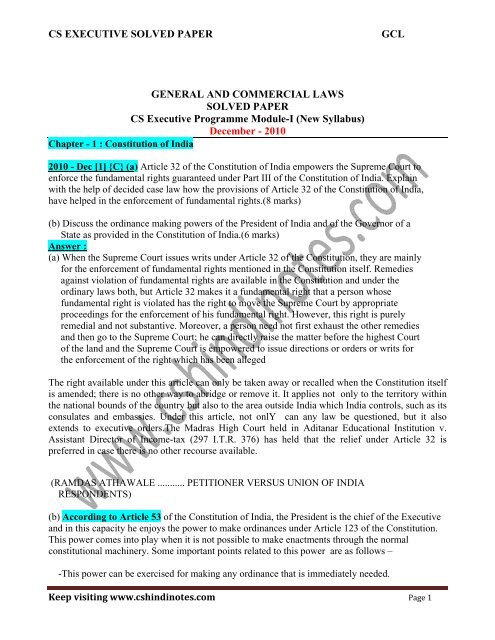
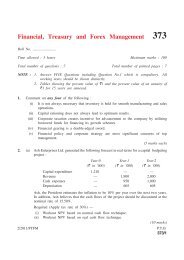

![vf/kfu;e dk vFkZ 'fu.kZ;' [ Interpretation of Statues ] Statue ... - cs notes](https://img.yumpu.com/38855798/1/190x245/vf-kfue-dk-vfkz-fukz-interpretation-of-statues-statue-cs-notes.jpg?quality=85)
